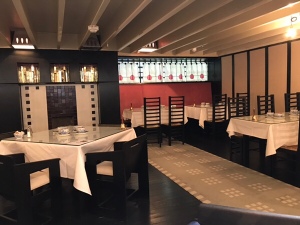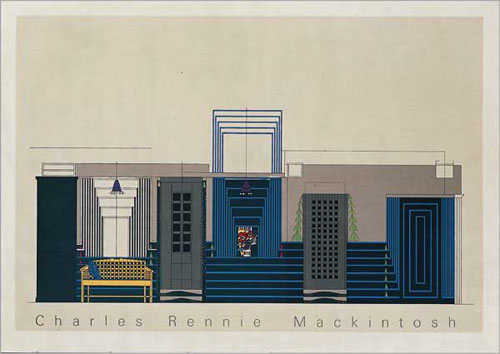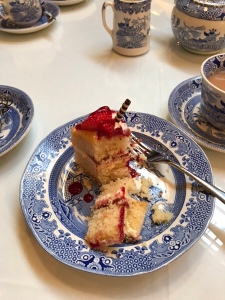
Glasgow is a wonderful city. I’m biased, as my seven Scottish cousins were born there. I love Scotland. Edinburgh is beautiful, and we visit it often; but Glasgow has that combination of grit and grace that speaks of its historic struggles, and the triumph of the artistic spirit over the industrial landscape.
One of Glasgow’s most famous sons is the architect and artist Charles Rennie Mackintosh, who very much epitomised the spirit of the age as the 19th century came to an end. That spirit of art rising from the ashes of industry was the driving force behind an artistic movement known as Art Nouveau.

Mackintosh was one of those polymaths who could do anything. He was an architect, designer, artist and, some would say, philosopher. His works ranged from iconic chairs to buildings, to… tea rooms.
In Glasgow, what are now known as the ‘Willow Tea Rooms’ are one of Mackintosh’s most famous legacies. There were four of them, and they provided Glasgow’s hard- working folk with a touch of class, transporting them from girders to a world of curves, colours and strange yet practical fantasy. Tea-rooms were, traditionally, the province of the middle-classes, but I could always imagine a working-class mum and dad dressing up their family after church on Sunday and taking them out for a high tea in the city centre.

The grandest of the Willow Tearooms, at 217 Sauchiehall Street, has recently been restored. Created by Mackintosh in the early years of the 20th century, it originally opened its doors in October 1903. It was the third in the Willow series of tea rooms commissioned by Catherine Cranston (known as ‘Miss’ Cranston), a wealthy hotelier and a leading figure in the Scottish Temperance movement. Her photograph, taken from Wikipedia, is below. (Attribution)

For the Sauchiehall Street (pronounced suck-e-hall) Willow Tea Room, Miss Cranston gave Mackintosh control of its design and construction – both outside and inside. It is therefore a rare example of the full spectrum of the architect’s talents.

As a result, the building reflected Mackintosh’s skill at its height, and, today, gives us a living example of turn of the century sophistication and art. The original building, prior to becoming the tea room, had been an 1860s tenement. One look at both the interior and the exterior shows the depths of the architect’s vision.
Tea drinking was seen as an alternative to the male-only pub and the city was keen to encourage it. By the 1880s, tea had become affordable and a new wave of tea rooms was sweeping Britain. Miss Cranston was eager to participate. She created an aspiring environment where there were separate rooms for women, men, and mixed groups. In that way, everyone was welcome – and no one needed to feel threatened. Very soon, everyone wanted to see and be seen in one of the Willows.

Art Nouveau developed first in Britain, then spread across mainland Europe. It had its origins in the Arts and Crafts movement, but also was heavily influenced – especially in the Glasgow School – by the influx of Japanese minimal forms in art. Japan had recently opened its doors to foreign trade in its art, and, because of engineering and shipbuilding links, Glasgow was one of the first cities to benefit.
The Arts and Crafts movement developed from the desire to bring beauty – and the skills of the individual craftsman – back into the lives of ordinary people. The middle classes were a growing economic force, and they were the ‘ordinary people’. The working classes were unlikely to be able to afford what it offered, but I like to think that the tea room offered a chance, occasionally, to bridge that gap. The inspiration of youngsters was one of Mackintosh’s passion, possibly because he and his wife, Margaret Macdonald, had no children of their own…
 The Sauchiehall Street Willow Tea Rooms has an interesting history. Catherine Cranston was happily married, though also childless. When her husband died in 1917, she felt heavy with grief and unable to continue in her public life. She sold off her tea rooms and her other businesses. When she died in 1934, she left two-thirds of the money in her will to the poor of Glasgow.
The Sauchiehall Street Willow Tea Rooms has an interesting history. Catherine Cranston was happily married, though also childless. When her husband died in 1917, she felt heavy with grief and unable to continue in her public life. She sold off her tea rooms and her other businesses. When she died in 1934, she left two-thirds of the money in her will to the poor of Glasgow.
Mackintosh carried out his last work for Catherine in 1917 with the extension of the Willow Tea Rooms into the basement of the building next door; to create what was known as the ‘Dug Out’. Later generations observed that the style of this extension (below) was very close to that adopted, later, by the Art Deco movement. (Picture Wikkiepdia)

The Sauchihalle Street Willow Tea Rooms building closed in 1928. The furniture was sold off and the building was converted for use by Daly’s department store. Daly’s moved to new premises in 1978 and various attempts were made to restore the surviving parts of the original interior. The building was and is greatly loved by the people of Glasgow, and, in 2014 the Willow Tea Rooms Trust was established as a charity, with the aim of acquiring Miss Cranston’s foremost Tea Rooms in Suchiehall Street and restoring it to its former glory as a working restaurant.
The other Willow Tea Rooms in the city, though at least partly designed by Mackintosh, are a separate commercial undertaking, and not part of this charitable trust.

Every attempt has been made to restore the working atmosphere of the original tea rooms, including the training and uniforms of the friendly staff. We had tea and cakes during our visit to Glasgow and can vouch for the excellent food and service.

If you’re in the city, pay it a visit. It’s a wonderful tribute to both Miss Cranston and Charles Rennie Mackintosh.
The latter had a less than happy end to his life. Disillusioned with the world of architecture, the couple had moved to Port-Vendres, a Mediterranean coastal town in southern France with a warm climate that was a cheaper place to live for the now poorer couple.
Mackintosh and his wife were content to paint landscapes and flowers, though he continued to explore the relationship between industry and the landscape. Sadly, they had to return to London in 1928 when the architect was diagnosed with cancer of the throat and tongue. He died on the 10 December, 1928. He was sixty years old.
The inner life of the man lives on in his works – and Miss Cranston’s Tea Room is one of the best. If you’re visiting Glasgow, go to Sauchiehall Street and take some tea… and possible a cake… or two.
In case anyone wonders, I’m not on commission; I just love Art Nouveau…and that cake!

©️Stephen Tanham.
Stephen Tanham is a director of the Silent Eye School of Consciousness, a not-for-profit organisation that helps people find the reality and essence of their existence via home-based, practical courses which are low-cost and personally supervised.
His personal blog, Sun in Gemini, is at stevetanham.wordpress.com.
You’ll find friends, poetry, literature and photography there…and some great guest posts on related topics.




























Love this post and Art Nouveau ..the cake looks ok too …I also love the work of Rennie Mackintosh a really nice post with lots of info I didn’t know. Thank you for sharing your wonderful trip, Steve 🙂
LikeLiked by 1 person
Thank you, Carol. You’d love it! 😊
LikeLiked by 1 person
I am sure I would, Steve I last visited Edinburgh a few years ago now but thought it was a lovely city 🙂
LikeLiked by 1 person
Most people opt for Edinburgh over Glasgow, but Glasgow has a lovely vibe… and a much better range of shops!
LikeLiked by 1 person
Yes I have heard but it was Edinburgh on business not fun..well not much…lol…Have scheduled your post for a reblog on Saturday as I really loved it 🙂
LikeLiked by 1 person
Thank you x
LikeLiked by 1 person
You are welcome it is a great post, Steve 🙂
LikeLike
To my American eye, the work of Rennie Mackintosh looks a LOT like the work of Frank Lloyd Wright. Now I am curious if these two men ever met & how they might have influenced each other. Thanks for the wonderful post … I would love to get to ANYWHERE in Scotland someday 🙂
LikeLiked by 1 person
I agree, Silverapplequeen (may I know your first name?). Certain ‘lines’ and curves emerged from the art movements of the 19th century. Many shared the overlap between architecture and art. Apparently the two men have been compared often, though Wright was much more successful as an architect. We visited FLW’s home in Arizona some years ago. Taliesin West, I think? It was a bit of a pilgrimage and well worth the distance. The two men never met. Journeys of greatness can be so sad….
LikeLike
You’ve certainly brought the place alive Steve. I’ve got to make a note of this place. We’re on holiday in Scotland from next week.
LikeLiked by 1 person
Ah, then Glasgow is well worth it, Jan. Make sure you go to the large Willow Tea Rooms on Sauchiehall Street, as there are two more!
LikeLiked by 1 person
Will do Steve.
LikeLiked by 1 person
Pingback: Miss Cranston’s Tea Room ~ Steve Tanham | Sue Vincent's Daily Echo
Thank you, Sue x
LikeLike
https://www.nts.org.uk/visit/places/the-hill-house
We walked past the tea rooms early in our day of walking ALL over Glasgow and never got back for my promised afternoon tea. However another day of our holiday we went To Hill House, I loved it.
LikeLiked by 1 person
It’s on our list to visit. Considered one of the finest examples of Mackintosh’s work. A very worthy cause to support.
https://www.nts.org.uk/visit/places/the-hill-house
LikeLiked by 1 person
Spent several Mackintosh inspired visits to Glasgow and beyond. Inc willow tea rooms. Such a shame about the fire. Lovely post and I want to go back. Now.
LikeLiked by 1 person
Thank you, Geoff. I could go back there, myself…
LikeLiked by 1 person
Great post, Steve. Mackintosh’s work is fabulous (and the cakes at the tea rooms are pretty good, too). I haven’t been since the restoration but hope to get there before too long.
LikeLike
It’s a wonderful place, Mary. The restoration is really good, and the service is smart and top notch. It gives you a real feel for how its must have been a century ago.
LikeLike
Pingback: Miss Cranston’s Tea Room | Retired? No one told me!
Thank you, Carol 😊
LikeLiked by 1 person
You are very welcome. Steve 🙂
LikeLike
Grand and refined, a love the art of tea. I see Asian and modernist influences here. Thank you!
LikeLiked by 1 person
Thank you, Marin. I love the products of that era, too.
LikeLiked by 1 person